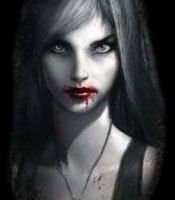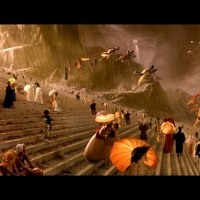Jack Frost is the personification of frost, ice, snow, sleet, winter, and freezing cold. He is sometimes described or depicted with paint brush and bucket colouring the autumnal foliage red, yellow, brown, and orange. Sometimes he is portrayed as a dangerous giant but, starting in late 19th century literature, more developed characterizations of Jack Frost depict him as a sprite-like character, sometimes appearing as a sinister mischief maker or as a hero. This mischievous sprite is traditionally said to leave the frosty, fern-like patterns on windows on cold winter mornings (window frost or fern frost) and nipping the extremities in cold weather. Over time, however, Jack Frost has become far less prevalent in the modern world due to the advance of double-glazing, but he remains a well-known figure in popular culture. He is a variant of Old Man Winter who is similarly held responsible for frosty weather, nipping the nose and toes in such weather, colouring the foliage in autumn, and leaving fern-like patterns on cold windows in winter. However, he also resembles other similar spirits of winter from around the world, including the Japanese Yuki-onna, Grandfather Frost in Russia and Mother Holle in Germany.
One of Jack Frost’s earliest appearances in poetry and literature is Hannah Flagg Gould’s 19th century poem The Frost, which features a mischievous being responsible for the quieter phenomena of winter, beautiful ice paintings on windows, but who also got upset at a lack of gifts and caused the cold to break and ruin things. In Charles Sangster‘s Little Jack Frost, published in 1875, Jack Frost is a playful being who runs around playing pranks and ‘nose-biting’, coating places with snow before being chased off by Mother Nature for spring. He may, however, originate in even more antiquated Anglo-Saxon and Norse winter customs. There are various other mythological beings who take on a similar role yet have different folklore to them. In Russia, Jack Frost has taken on a different form as Grandfather Frost, and in Germany there is instead a different entity altogether known as Mother Holle. Holle, who is also called Hulda or Old Mother Frost, is related to the Germanic figure of Perchta. She dwells at the bottom of a well, rides a wagon, and first taught the craft of making linen from flax. Holle is the goddess to whom children who died as infants go, and is alternatively known as both the Dunkle Großmutter (Dark Grandmother) and the Weisse Frau (White Lady), elements which are more typically associated with Grimm’s fairy tales. Her connection to the spirit world through the magic of spinning and weaving has associated her with witchcraft in Catholic German folklore.
Yuki-onna (or snow woman) is a spirit or yōkai in Japanese folklore. She is also a popular figure in Japanese literature, film, and animation. Yuki-onna comes from old times, and in the Muromachi period Sōgi Shokoku Monogatari by the renga poet Sōgi, there is a statement on how the poet saw a yuki-onna when he was staying in Echigo Province (now Niigata Prefecture), indicating that the legends already existed in the Muromachi period. In the legends Yuki-onna appears on snowy nights as a tall, beautiful woman with long black hair and blue lips. Her inhumanly pale or even transparent skin makes her blend into the snowy landscape (as famously described in Lafcadio Hearn’s Kwaidan: Stories and Studies of Strange Things). She sometimes wears a white kimono, but other legends describe her as nude, with only her face and hair standing out against the snow. Despite her inhuman beauty, her eyes can strike terror into mortals. She floats across the snow, leaving no footprints (in fact, some tales say she has no feet, a feature of many Japanese ghosts), and she can transform into a cloud of mist or snow if threatened. Some legends say the Yuki-onna, being associated with winter and snowstorms, is the spirit of someone who perished in the snow. She is at the same time beautiful and serene, yet ruthless in killing unsuspecting mortals. Until the 18th century, she was almost uniformly portrayed as evil. Today, however, stories often colour her as more human, emphasizing her ghost-like nature and ephemeral beauty.
Jack Frost has likewise appeared as a character in television and movies. He was mentioned in the wintertime song “The Christmas Song” (aka “Chestnuts Roasting on an Open Fire”). He has been presented as a villain in some media and a hero in others. In L. Frank Baum’s The Life and Adventures of Santa Claus (1902), Jack Frost is the son of the otherwise unnamed Frost King. He takes pleasure in nipping “scores of noses and ears and toes”, but Santa Claus, who likes Jack (who he sees as a “jolly rogue”) though he mistrusts him, asks him to spare the children (Jack says he will – if he can resist the temptation). In Laurell K. Hamilton’s Meredith Gentry series, a character emerges as the original Jack Frost. In the novel Hogfather by Terry Pratchett, Jack grows tired of “fern patterns” and paints more elaborate pictures on windows. Jack Frost appears as the protagonist of Rise of the Guardians voiced by Chris Pine. Jack Frost is getting tired of being unseen and is suddenly forced to join the Guardians (which consists of Santa Claus, the Tooth Fairy, the Sandman, and the Easter Bunny) to defeat the Bogeyman (aka Pitch Black). This version of Frost is portrayed as a fun-loving teenage boy who has no interest in being bound by rules or obligations and just wants to use his magical staff to spread his winter magic for the sake of his amusement, and for the amusement of others. Perhaps you’ll think of the many faces of Jack Frost this winter – if you happen to see a pattern of frost on your window…













As far as Baum goes, Jack is also a significant character in the short story “The Runaway Shadows.” And there was a Rankin-Bass animated special about him.
Interesting entry. From what you write Yuki-onna seems like a character very similar to Andersen’s Snow Queen 🙂